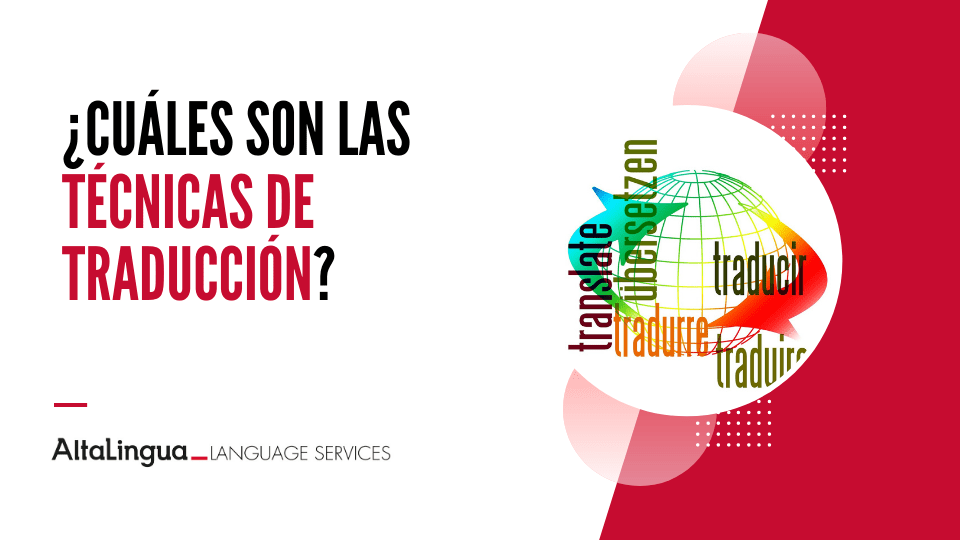-
Translation Techniques
The different translation techniques are translation mechanismsto achieve the best result in the target language translation consists of conveying the same message from one language to another, taking into account the culture, space and time of the source language and the target language.
There is a clear difference between translation techniques and translation methods.
Translation methods are applied for the whole text, while translation techniques are applied differently within the same text, depending on what is more convenient.
A good translator must have sufficient knowledge to know how to use the different translation techniques appropriate for each content.
The most common translation techniques
Modulation
Modulation is a translation technique in which the message is varied by a change of perspective or semantic change.
Example of modulation in a translation:
Don’t get so excited – Tranquilízate
Transposition
Transposition consists of making a change in the grammatical structure of the sentence without altering its meaning.
Example of transposition in a translation:
I won’t be late – No tardaré
I won’t be late – No tardaré
I won’t be late.br class=”xliff-newline” />Literal translation
Literal translation or metaphrase is a translation technique with no room for double meanings, i.e. the text is translated literally without altering its structure or meaning.
This technique is rarely used, as there are not many words with a single translation in a language. In addition, the meaning and sense of the text is often lost, as with machine translators.
Literal translation is only possible word for word or in cases where the source and target language have a complete correspondence in structures, which is almost never the case and the result would be forced and unnatural.
Example of literal translation:
I won’t be late – Yo no llegaré tarde
Calco
Calc is a translation technique very similar to literal translation, although calc is taking an expression from the source language and translating it into the target language without the need to respect its structure.
Example of the inlining technique in a translation:
Handball, football – Balonmano, balompié
Loaning
Semantic borrowing consists of using a word or expression from the source text in the target text. It is usually marked in italics to identify this type of translation technique. This is common in marketing content (“marketing” term accepted by the RAE) or in sectors of new trends or innovations whose terms are popularized in the source language. The use of this technique will depend
Example of the borrowing technique in a translation:
Software, hardware, vedette…
The use of the borrowing technique will depend on the acceptance of the term in the target language, variant or audience of the content.
Example of variant borrowing technique in a translation:
Mouse (hardware) – Mousefor Latin America and “ratón” for Spain.
Equivalence
Equivalence consists of translating a text using structural and stylistic resources that are totally different from the source language. The equivalence translation technique always seeks to be faithful to the original message and to maintain the tone and all the intentions of the original and is common in sayings or popular proverbs that have a non-literal meaning of the words used.
Example of equivalence in a translation:
It’s raining cats and dogs – Llueve a cántaros.
Adaptation
Adaptation is a translation technique in which the cultural elements of the source language are adapted to the culture of the target language.
Example of adaptation in a translation:
Taking tea in England, is known as having a coffee in Spain
Why are translation techniques important?
Translation techniques are essential in order to achieve a quality translation that translates all the nuances and intentions of the original into the target language. The technique that the translator considers most appropriate at any given time will be used to convey all the nuances of the original content.
Other interesting articles for translators:
At AltaLingua we translate into all languages with professional translators who are
native speakers and trained in Translation and Interpretation
Request a free translation quote.
AltaLingua
AltaLingua es una agencia de traducción e interpretación de referencia en España que brinda servicios lingüísticos integrales para empresas en España y el mundo. AltaLingua cuenta con sistemas de gestión de calidad según las normas ISO 9001:2015, ISO 18587:2020 de servicios de posedición multilingüe y UNE-EN 17100:2015 de servicios de traducción. https://altalingua.es/
- altalingua@altalingua.co.uk
- Customer Area
